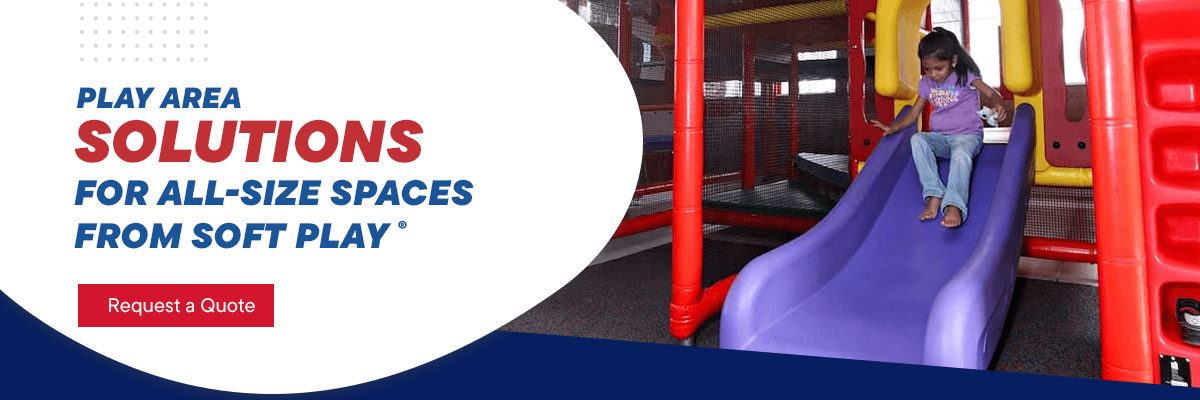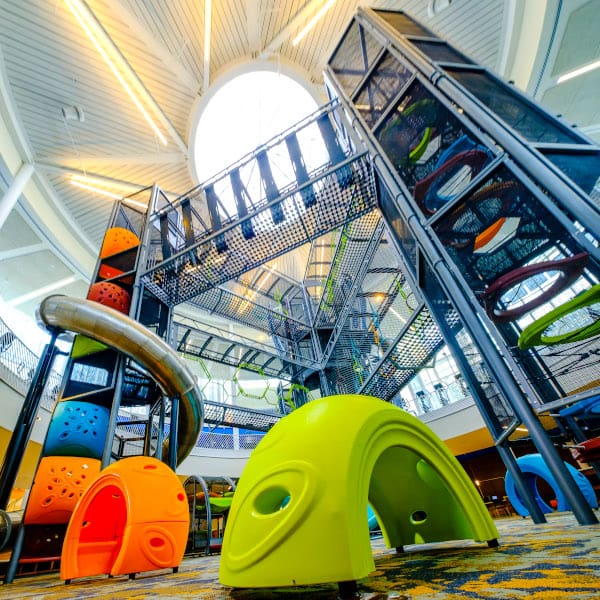Tips for Designing a Small Playground
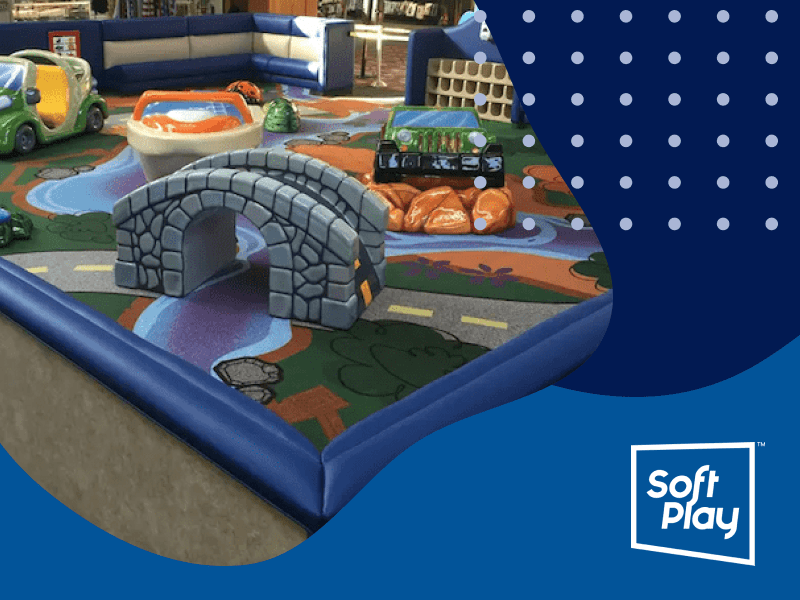
Tips for Designing a Small Playground
Designing a playground or play area is a comprehensive task, and there are even more considerations when planning for a small play area. You can incorporate many, if not all, of your ideas when designing a larger playground. With a smaller play space, it’s important to be more mindful about which elements make the cut.
The right insights and tips for designing a small playground can help you maximize space and incorporate the elements that matter most.
The Benefits of Designing a Small Playground
Designing a small playground has its challenges, but it also offers several benefits, from being more accessible and inclusive to offering a space that needs less maintenance.
- Prioritizing accessibility and inclusivity: One of the most significant benefits of designing for a smaller space is that it can be easier to make your play area more accessible and inclusive. Large areas with many entrances and numerous different components require more extensive playground planning to ensure they comply with the Americans With Disabilities Act (ADA).
- Lower maintenance and cost-savings: Another major perk of designing a small playground is the cost-saving and time-saving benefits, including lower maintenance needs. With fewer components and a smaller space to manage, budget-friendly playgrounds allow you to spend less time on installation and maintenance.
- Fostering community: Smaller playgrounds can help foster and strengthen community ties between parents and kids. Parents and kids are more likely to interact with one another in a smaller space that provides a sense of unity.
- Versatility: Smaller playgrounds can be a versatile component for your establishment. For example, a small indoor playground can be a section of larger parents and tots areas, a part of waiting rooms or an attractive feature in restaurants or resorts. The beauty of smaller playgrounds is that they don’t have to be stand-alone attractions — they can be smaller structures you can easily add to your establishment without requiring much space.
- Stimulation and development: Even though your playground design is for a small space, it can still offer the benefits of large play areas. No matter the size, a well-designed playground promotes physical activity, enhances social skills, stimulates kids’ cognitive development and physical skills, and encourages creativity, imagination and independence.
Key Considerations for Small Playground Design
In many aspects, designing a smaller play area is similar to other types of playground design. There are elements you’ll want to prioritize, no matter the size of the area you’re designing. For any play area, you want a playground that stimulates kids, is accessible and reliable, and is made with quality components.
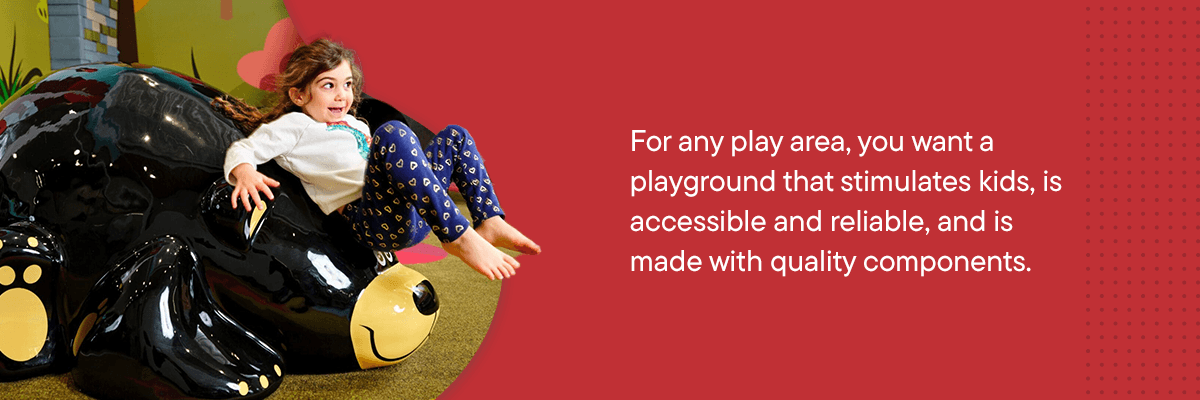
Optimizing Available Space
Space optimization is one of the primary considerations for small playground designs. You can maximize limited space for your play area design in a few ways, including vertically and prioritizing multifunctional equipment. These two design elements make a considerable difference in how much you can get out of a smaller play area — and, more importantly — how much more you can offer to the families who will use the space.
- Vertical space: Designing a playground that takes advantage of vertical space is one of the best ways to transform a small area into an enjoyable and practical playground. You can incorporate vertical height by having climbing structures, layered crawl spaces, slides, swings, bridges and towers.
- Multifunctional equipment: Interactive and multifunctional equipment are game changers for designing smaller play areas. These components truly help you get the most out of a small space, as one structure can offer several different elements. For example, a fun lookout tower can also have climbing elements and interactive panels.
- Compact options: Reliable playground manufacturers often offer compact versions of classic play components. Opting for compact equipment allows you to incorporate more play area staples like seesaws and swings while still being mindful of space.
Creating a Smart Layout
Creating the right layout is a top consideration. You’ll want the space to flow properly while maximizing every inch available. Here are some helpful ideas:
- Measure accurately: In addition to taking accurate measurements for the length and width of the space the playground will occupy, consider the limit on the height you can use for building vertically. Other factors to consider include irregular boundaries and oddly shaped spaces or corners.
- Design for the shape of the space: For an intuitive and effective play area, design your playground to fit the existing layout of your space. There are various ways you can do this — you don’t have to match the shape of your playground to the exact shape of the space. What’s most important is determining a design that gets you the most out of your space.
- Be aware of limitations: Obstacles like fences, utility lines and trees will naturally factor into the design of your play area. Inside, consider the current use of the space and how you might design around walkways, doors and tables.
- Create clear pathways for movement: While it’s tempting to try to incorporate as many play components as possible so the small area still feels comprehensive and functional, this can make the area feel cluttered and cramped. It’s typically better to prioritize a “less is more” approach by choosing a couple of core components and allocating the rest of the space to designing clear pathways and open spaces to help the area feel bigger.
- Zone areas for different types of play: Zoning play areas is a great way to make your small playground feel like it offers a lot and is more interactive. Rather than having one small structure that offers one element of play, you can have a structure that offers various elements of play through effective zoning.
- Get clever with colors: Color is a vital part of playground design, as it can have a powerful effect on kids and the look of your design. Color can stimulate the brain in various ways and inspire imagination. When designing for a small space, you typically want to use fewer colors to create a more streamlined effect so that your space feels bigger. However, you also want to be mindful of achieving a balance of bright colors that provide sensory stimulation and muted colors to calm the senses.
Designing for Your Core Users
Designing for your core audience is key regardless of the size of your playground, but it becomes especially important when you need to prioritize components to save space.
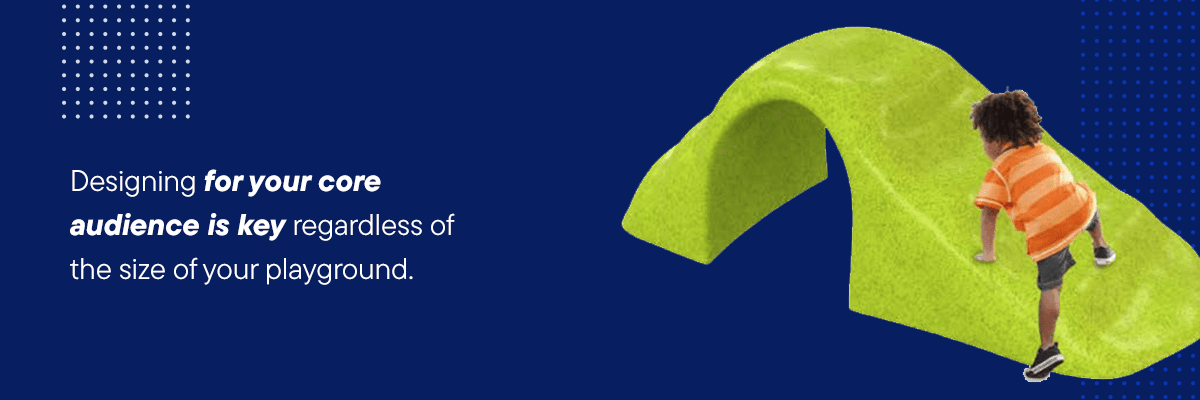
Usually, the age of the kids you want to serve is the primary consideration for choosing small playground equipment. To design a play area for different age groups, keep the following in mind:
1. Ages 2 to 5
A lower height for all the playground components is ideal for toddlers and preschoolers. This makes it easier for kids to access and enjoy the various elements in your play area. Ensure a lower height for all structures, including decks, platforms, bridges, crawling spaces and slides. Including playground components for stimulating development is something parents always appreciate. You can incorporate interactive elements like built-in musical components and turning parts for fine motor skills development.
2. Ages 6 to 12
For playgrounds for older kids, you can design structures with taller heights, including higher swings, platforms and towers. Structures for the older age group can also have more physically challenging components like climbing frames, ropes, ladders and hanging bars. The structures should still have kid-friendly, sturdy components like soft play equipment.
3. Teens
The components of a successful play area design for teens include having physically challenging and adventurous components like obstacle courses, full climbing structures and interactive elements that incorporate technology.
Meeting Regulations and Standards
Compliance with industry regulations and standards is an essential part of playground design and choosing a manufacturing partner. To design a more reliable and high-quality play area, keep the following in mind so that you can adhere to industry guidelines:
- Third-party testing: Ensure third-party tests are completed on all components for compliance with various flame and fire test ratings. Design your playground using fire-resistant and antibacterial materials.
- Relevant products and materials benchmarks: Confirm that components meet or exceed benchmarks set by the American Society for Testing and Materials and the Consumer Products Safety Improvement Act.
- ADA standards: A few ways to make your playground design more accessible include having entrances that are wide enough to easily fit strollers and wheelchairs, designing pathways that suit kids with various mobility needs, and using the correct, impact-absorbing playground surfacing, such as Pour-in-Place rubber and Modular Tiles.
How to Design Small Inclusive Playgrounds
Accessibility is a significant focus in playground design, but inclusivity can often be overlooked.
Accessibility standards for playgrounds focus more specifically on making essential and practical provisions and adjustments for stroller and wheelchair users, such as appropriate surfacing and user-friendly entrances, exits and seating areas. Inclusive designs explore broader ways to ensure kids of all backgrounds and abilities feel welcomed and involved.
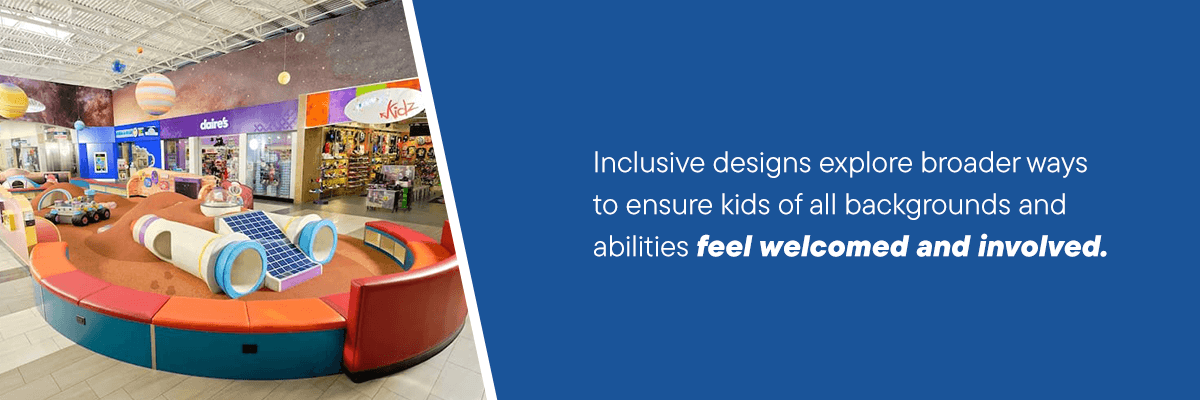
Thankfully, it can be easier to make a smaller playground more accessible and inclusive, as there isn’t as much space and as many components to adjust. Some ideas to make your small playground more inclusive include:
- Zoning: Zoning is an excellent way to ensure you are catering to kids with different sensory needs. Having “busy” sections and “quiet” sections can help accommodate different sensory needs and capacities. You can also zone areas by levels of social activity, including solitary, parallel and cooperative play.
- Inclusive components: With the right playground manufacturer, you can design play areas with inclusive components that allow more kids with various abilities to participate. Inclusive swings accommodate various mobility needs, and inclusive slides with a lower point of transfer and wider design allow kids using wheelchairs to play on the equipment, too.
- Various challenge levels: A simple but effective way to make your small playground more inclusive is to choose a couple of components that provide varying levels of challenges and difficulties. They can be components like inclusive swings and slides that are user-friendly for kids of all abilities and then more challenging structures like climbing structures.
Big Ideas for Small Playgrounds
At Soft Play®, we offer an extensive range of customizable indoor and outdoor playgrounds and play area components. We work carefully alongside you to create play areas that suit your needs and the community’s needs, including designing and manufacturing compact playgrounds for smaller spaces.
Our collection of small contained play areas is the perfect starting point for creating a fun environment while prioritizing space. Our small, contained playground designs include Atom, Under the Sea, FarmLand and several other customizable designs. These compact designs are perfect for spaces with low ceilings or smaller floor areas.
We also offer various components for creating custom play spaces, like playgrounds for smaller spaces. Some examples of our indoor play components include:
-
- Classic elements like slides and swings
- Stimulating play panels like the Lady Bug Game and Abacus and the interactive STOMP challenge
- Inclusive components that are ADA-compliant
- Themed Pick & Play sculpted foam systems
- Elementz products like the Wonder Dome, Action Tunnel, Adventure Arches and Stepping Pods
- Wonderscapes pre-designed soft sculpted foam and contained play products
Play Area Solutions for All-Size Spaces From Soft Play
A meaningful playground design is the foundation of creating a play area that engages families, regardless of the size you’re working with. Big and small playgrounds can leave a positive and lasting impression on your community when they’re designed mindfully and using quality components.
If you have a small space you’d like to transform into a busy playground that kids love, Soft Play can help you design and create the ideal play area for your establishment. By working with our professional team of designers and manufacturers, you can have a memorable play area that suits your small indoor or outdoor areas.
In addition to our components for small outdoor play spaces and compact indoor areas, we also provide products and services for aquatic areas, site amenities, safety surfacing and themed playground design. We also stand out by offering ADA-compliant equipment for more accessible and inclusive spaces that kids of all abilities and backgrounds can enjoy.
Start designing and creating unique custom playgrounds by contacting us for a free design consultation. You can also request a quote today!
